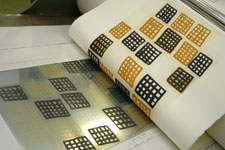about

Collecting Prints: a quick guide to terms and ethics.
1. What is an "edition" of prints?
Edition refers to all impressions of a particular image that are printed after the artist has given an approval to print. Generally, the edition includes all numbered prints, the artist's proofs, the bon à tirer, which is given to the printer, and 3 impressions for workshop archives. All impressions, including the trial proofs, colour trial proofs, and artist's impressions, are documented.
2. What are artist's proofs and how many should there be?
Artist's proofs (sometimes designated A/P or E/A- french, épreuve d'artiste) are impressions just like those in the numbered edition. They are set aside for the artist's personal use. Workshops should limit the number of artist's proofs to a maximum of five, or up to ten percent of the signed and numbered impressions.
3. Who determines the quantity of numbered impressions?
Generally the artist and the workshop decide together before the edition is printed. These days, the number is rarely more than fifty numbered impressions and is often considerably smaller. The edition size is often a very good clue to determining if the prints were printed by hand, or if they are part of a large, mechanically produced edition.
4. If all the prints in the edition are sold, do you print more?
Never! After the artist signs and numbers each impression in the edition, all stones and plates are effaced and regrained for future use.
5. What do the numbers on prints mean?
Usually there are two numbers separated by a slanted line- 25/30. The bottom number tells you how many impressions there are in the numbered edition; the top number is simply the specific designation for that impression.
6. Are some prints in the edition more valuable or better than others?
No. In contemporary print editions, an impression with a lower number is no more valuable or better than an impression with a higher number. This popular misconception probably stems from the time when very large editions of prints were made and impressions were sometimes pulled after the printing element began to wear out, resulting in impressions that were not as "crisp" as the first few printed.
More importantly, it is also true that prints are not signed and numbered in the order in which they were printed. Uniformity among impressions is assured because the curator checks each impression against the bon à tirer. Only those impressions meeting high standards are embossed with the identifying symbols, called chops, of the workshop and the printer; any flawed impressions are destroyed.
7. If I'm buying a print, should I make sure it has chops?
The chops are important identifying features, but not all original, limited edition prints will have them. Artists who print their own work may not use them. You should, however, always ask for documentation.
8. What kind of documentation should I ask for?
Most reputable printshops and galleries have a documentation sheetfor each of their prints, giving a complete description of the print and the steps involved in its making. These documentation sheets are available to anyone who asks.
9. Do documentation sheets guarantee a print's originality?
Not necessarily. Unfortunately, documentation sheets can be misleading. Read the sheets carefully and ask questions about anything that is unclear. If you are in doubt about a print's authenticity or value, it's best to check with a reputable dealer or a museum print department.
10. Are prints that are photomechanically produced "fakes"?
Not necessarily. The important distinction here is between the words produced and reproduced. If an artist and a printer agree to use photographic means to print an image originally conceived for that particular print, which is both limited and documented, then it falls within the concept of an original print. However, a print that exactly reproduces an existing image (such as a painting), in another medium, would not normally be considered an "original work of art."
1. Conseil québécois de l'estampe,
A Code of Ethics for the Original Print 1990
2. Gasciogne, Bamber
How to Identify Prints
New York: Thames and Hudson 1986
© 2016 Ulrich Kühle Sarah Dudley GbR • All rights reserved.
